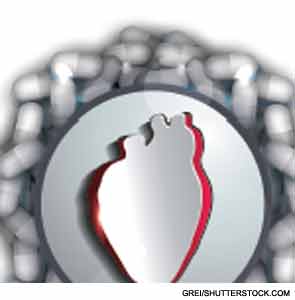
The “2013 Guideline on the Treatment of Blood Cholesterol to Reduce Atherosclerotic Cardiovascular Risk in Adults,” released by the American College of Cardiology and the American Heart Association, identifies four groups of people who are most likely to benefit from statin therapy, recommends high-intensity and moderate-intensity statin therapy doses for secondary and primary prevention, and notes that there is no evidence from randomized controlled trials to support specific low-density lipoprotein (LDL) cholesterol or non–high-density lipoprotein (HDL) cholesterol treatment targets.1
The guideline reiterates the “strong evidence” related to the benefit of statin therapy for patients at risk of atherosclerotic cardiovascular disease (ASCVD), according to Jorge Plutzky, MD, director of the Vascular Disease Prevention Program and associate professor at Harvard Medical School in Boston. “We do not have definitive evidence that patients with rheumatologic diseases are at as high a risk as patients with diabetes; however, there is a lot of interest in the notion that they do have increased cardiovascular risk.
“Rheumatologists should see [this guideline] as support for considering starting therapy for their patients with rheumatologic diseases and inflammatory disorders and for using statins at appropriate doses,” Dr. Plutzky says.
Reduction in ASCVD Risk
The guideline is based on data from randomized controlled trials as well as systematic reviews and meta-analyses of randomized controlled trials. It focuses on lipid management for the reduction in risk of ASCVD and reiterates the importance of a heart-healthy diet, regular exercise, avoidance of tobacco, and maintenance of a healthy weight as critical components in risk reduction. Additionally, the guideline makes clear that nonstatin therapies “do not provide acceptable risk reduction benefits compared with their potential for adverse effects in routine prevention of ASCVD.”1
Physicians are encouraged to use a new risk calculator developed for the guideline to assess a patient’s 10-year risk of ASCVD (defined as first occurrence of nonfatal and fatal myocardial infarction and nonfatal and fatal stroke).2 The calculator assesses risk based on blood pressure, smoking and diabetes status, age, and sex; it can be used to predict stroke and coronary heart disease events in non–Hispanic Caucasian and African-American women and men aged 40 to 75 years, with or without diabetes, who have LDL cholesterol levels of 70 to 189 mg/dL. The guideline underscores the importance of statin therapy for patients with diagnosed ASCVD—defined as coronary heart disease, stroke, and peripheral arterial disease—and for those with primary lipid disorders.
Controversy about the validity of the risk assessment algorithm for other individuals and whether it overestimates risk, a recent topic of debate in medical journals and other venues, has added an unintended level of confusion about its use in clinical practice.3,4 Even though statins appear safe and effective “in the vast majority of patients taking them, the new guideline has added confusion, not clarity, regarding appropriate patient selection,” says Daniel Solomon, MD, MPH, chief of the section of clinical sciences in the division of rheumatology at Brigham and Women’s Hospital in Boston, and professor of medicine at Harvard Medical School. “The controversy over the risk calculator needs to be resolved before most doctors will change their practice,” he says, adding that he doubts that physician behavior will change until the American Heart Association and the American College of Cardiology clarify the validity of the calculator.
Dr. Plutzky says that rheumatologists could consider using the new risk calculator along with the Framingham Risk Score and the Reynolds Risk Score, which includes the patient’s C-reactive protein measurement. Using the three together could give a better “picture of risk when combined with one’s own good judgment,” he says. Determining the level of risk can be particularly challenging for rheumatologists when the patients are young and have inflammatory conditions, he says. For example, a young woman about 29 or 30 years of age who has significant inflammatory disease, has stopped menstruating, and has some hypertension “is not a typical 29- or 30-year-old,” he says. Physician judgment is critical, and decisions about therapy should be made in discussion with the patient, he says.
The new guideline supports that observation, noting the importance of clinical judgment for several patient groups where there are insufficient data from randomized controlled trials: young people with a low estimated 10-year ASCVD risk but a high lifetime ASCVD risk based on single strong factors or multiple risk factors, and individuals with rheumatologic or inflammatory disease. The guideline encourages physicians treating these patients to use their clinical judgment, “weighing potential benefits, adverse effects, drug–drug interactions, and patient preference.”
Dr. Plutzky says that physicians should remember that, “guidelines are exactly that. Guidelines are not law, and one has to rely on clinical judgment to decide what is appropriate in terms of the patient sitting across from you and what works for them.”
According to the new guideline, statin therapy for ASCVD risk reduction would clearly benefit four major groups of people, and the benefit of that therapy would outweigh the risk of adverse events.
Recommended Groups for Treatment
According to the new guideline, statin therapy for ASCVD risk reduction would clearly benefit four major groups of people, and the benefit of that therapy would outweigh the risk of adverse events. These four groups include individuals who:
- Have clinical ASCVD (defined as acute coronary syndromes, or a history of myocardial infarction, stable or unstable angina, coronary or other arterial revascularization, stroke, transient ischemic attack, or peripheral arterial disease presumed to be of atherosclerotic origin);
- Have primary elevations of LDL cholesterol of 190 mg/dL or higher;
- Have diabetes, are 40 to 75 years old with LDL cholesterol from 70 to 189 mg/dL, and without clinical ASCVD; or
- Have no clinical ASCVD or diabetes, have LDL cholesterol from 70 to 189 mg/dL, and have an estimated 10-year ASCVD risk of 7.5% or higher. (Patients in this group who are not being treated with cholesterol-lowering drug therapy should have their 10-year ASCVD risk recalculated every four to six years, according to the guideline.)
Specific information is included in the guideline about when high-, moderate-, and low-intensity statins are recommended, depending on the patient group and level of risk. The high-intensity statins atorvastatin and rosuvastatin have been evaluated in randomized controlled trials and were shown to reduce major cardiovascular events. The guideline also lists moderate-intensity and low-intensity statin therapies that have been evaluated.
Most surprising to some is the new guideline recommendation that treatment not be focused on the LDL level, which has been targeted at 70 mg/dL or lower, or on non–HDL cholesterol targets for primary or secondary prevention. “The backing away from treating to a target LDL is interesting and surprising,” Dr. Solomon says. “It is based on the fact that most statin randomized controlled trials do not use a treat-to-target strategy. Having said that, there are very strong data that more aggressive lipid lowering is associated with a continued reduction in risk,” he says.
“We know that patients with several systemic rheumatic diseases are at an increased risk for cardiovascular disease, and prior research suggests that statin prescribing in rheumatology patients is suboptimal. It is very easy for patients with a dominant condition like rheumatoid arthritis to have routine health maintenance overlooked,” Dr. Solomon says. “Rheumatologists can feel comfortable using the earlier version of the lipid guidelines to select patients for recommending statins.”
Clear evidence-based guidance on managing lipids in patients with rheumatoid arthritis is needed, according to Dr. Solomon. He says that data from a large statin trial for rheumatoid arthritis conducted in the U.K. are expected soon and “may help clarify treatment recommendations” for these patients.
Kathy Holliman is a medical journalist based in New Jersey.
References
- Stone NJ, Robinson J, Lichtenstein AH, et al. 2013 ACC/AHA guideline on the treatment of blood cholesterol to reduce atherosclerotic cardiovascular risk in adults: A report of the American College of Cardiology/American Heart Association task force on practice guidelines. J Am Coll Cardiol. 2013 Nov 7. [Epub ahead of print]
- American Heart Association. 2013 Prevention Guidelines Tools: CV Risk Calculator. http://my.americanheart.org/professional/StatementsGuidelines/PreventionGuidelines/Prevention-Guidelines_UCM_457698_SubHomePage.jsp. Accessed Dec. 11, 2013.
- Ioannidis JPA. More than a billion people taking statins?: Potential implications of the new cardiovascular guidelines. JAMA. 2013 Dec 2. [Epub ahead of print]
- Ridker PM, Cook NR. Statins: New American guidelines for prevention of cardiovascular disease. Lancet. 2013;382:1762-1765.

